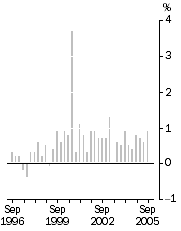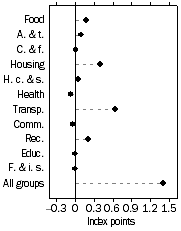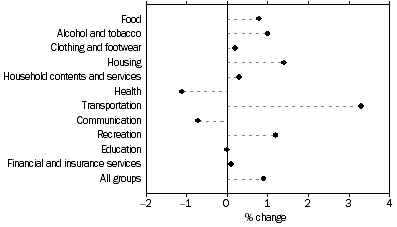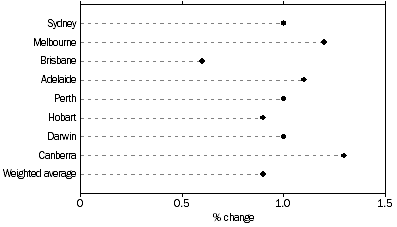Price indexes and contract price indexation
1 ALL GROUPS, INDEX NUMBERS(A)
2 ALL GROUPS, PERCENTAGE CHANGES
CPI All GROUPS, WEIGHTED AVERAGE OF EIGHT CAPITAL CITIES, INDEX NUMBERS(a)
SEPTEMBER QTR KEY FIGURES
 | Jun Qtr 2005 to Sep Qtr 2005 | Sep Qtr 2004 to Sep Qtr 2005 |  |
| Weighted average of eight capital cities | % change | % change |  |
|  |
| Food | 0.8 | 3.3 |  |
| Alcohol and tobacco | 1.0 | 3.5 |  |
| Clothing and footwear | 0.2 | -1.8 |  |
| Housing | 1.4 | 3.9 |  |
| Household contents and services | 0.3 | 0.8 |  |
| Health | -1.1 | 4.6 |  |
| Transportation | 3.3 | 5.9 |  |
| Communication | -0.7 | -1.0 |  |
| Recreation | 1.2 | 1.4 |  |
| Education | 0.0 | 6.3 |  |
| Financial and insurance services | 0.1 | . . |  |
| All groups | 0.9 | 3.0 |  |
| All groups excluding Housing and Financial and insurance services | 1.0 | 3.0 |  |
|  |
| . . not applicable |
All Groups, Quarterly change

| Contribution to quarterly change, September quarter 2005

|
SEPTEMBER QTR KEY POINTS
THE ALL GROUPS CPI
- rose 0.9% in the September quarter 2005 compared with 0.6% in the June quarter.
- rose 3.0% through the year to September quarter 2005.
OVERVIEW OF CPI MOVEMENTS
- Contributing most to the overall increase this quarter were automotive fuel (+11.6%), house purchase (+1.2%), domestic holiday travel and accommodation (+3.4%), property rates and charges (+5.0%), beer (+1.8%), overseas holiday travel and accommodation (+2.0%), fruit (+3.0%), restaurant meals (+1.4%), rents (+0.6%), electricity (+1.7%) and water and sewerage (+3.0%).
- Partially offsetting these increases were falls in pharmaceuticals (-4.8%), deposit and loan facilities (-0.7%), audio, visual and computing equipment (-1.7%) and telecommunication (-0.7%).
- Using the points contribution data presented in table 7, the All groups CPI would have risen 0.5% in the September quarter 2005 if the effect of automotive fuel was excluded.
NOTES
CHANGES IN THIS ISSUE
This issue introduces the 15th Series Australian Consumer Price Index. It incorporates an updated weighting pattern and some structural changes including the introduction of financial services into the CPI in a new group 'Financial and insurance services'. For more details of changes resulting from the introduction of the 15th Series CPI, refer to Information Paper: Introduction of the 15th Series Australian Consumer Price Index (Reissue) (cat. no. 6462.0), which was released on 11 October 2005. Details of the new weighting pattern have also been released in Consumer Price Index: 15th Series Weighting Pattern (Reissue) (cat. no. 6430.0).
Appendix 1 of this issue describes the special and analytical series presented in tables 8, 9 and 10 of this publication. There have been some changes to the groups, sub-groups and expenditure classes contributing to each of the special series as a result of the introduction of the 15th Series CPI.
Appendix 2 summarises the changes to the CPI Commodity Classification resulting from the introduction of the 15th Series CPI.
The series 'All groups excluding Housing and Financial and insurance services' for Singapore, shown in the International Comparisons tables 11 and 12, has been revised. The Singapore Department of Statistics has advised that it has rebased and reweighted its CPI, which resulted in revisions to the previously published data.
INQUIRIES
For further information about these and related statistics, contact Steve Whennan on Canberra (02) 6252 6251 or the National Information and Referral Service on 1300 135 070.
ANALYSES AND COMMENTS
MAIN CONTRIBUTORS TO CHANGE
CPI GROUPS
Weighted average of eight capital cities, Percentage change from previous quarter

The discussion of the CPI groups below is ordered in terms of their significance to the change in All groups index points (see tables 6 and 7).
TRANSPORTATION (+3.3%)
The increase in transportation costs was predominantly due to automotive fuel (+11.6%). Automotive fuel prices rose in April (+4.0%), fell in May (-3.9%) and rose in June (+1.1%), July (+4.9%), August (+5.9%) and September (+9.1%). This increase was partially offset by falls in motor vehicles (-0.2%) and motor vehicle repair and servicing (-0.8%).
Through the year to September quarter 2005, transportation prices rose 5.9%.
The following graph shows the pattern of daily price behaviour for unleaded petrol for the eight capital cities over the last 15 months.
HOUSING (+1.4%)
All categories of housing recorded price rises this quarter with house purchase (+1.2%), property rates and charges (+5.0%), rents (+0.6%), electricity (+1.7%), water and sewerage (+3.0%), house repairs and maintenance (+0.8%) and gas and other household fuels (+2.0%) contributing to the increase.
House purchase rose in all capital cities except Brisbane, with builders reporting material costs and labour and tradesmen's costs as the main contributing factors. Brisbane's house purchase fell slightly (-0.1%), which some Brisbane builders attributed to a softening in the new housing market. The increase in property rates and charges, electricity and water and sewerage was mainly due to the annual review of these prices by State and local government authorities and utilities providers.
Through the year to September quarter 2005, housing prices rose 3.9%.
RECREATION (+1.2%)
The increase in the recreation index was mainly due to domestic holiday travel and accommodation (+3.4%), overseas holiday travel and accommodation (+2.0%), sports participation (+2.1%) and pets, pet foods and supplies (+4.0%). These rises were partially offset by a fall in audio, visual and computing equipment (-1.7%).
The rise in domestic holiday travel and accommodation was due to increases in both the fares and accommodation components with peak prices applying in both the first and last month of the quarter, coinciding with the occurrence of school holidays in most capital cities at some time in these two months. The rise in overseas holiday travel and accommodation was attributable to increased airfares to most surveyed destinations, coinciding with the shoulder/peak season in Asia and continuing peak season in Europe and North America.
The fall in audio, visual and computing equipment was mainly due to discounting and price falls for a number of home entertainment items by major retailers.
Through the year to September quarter 2005, the recreation index rose 1.4%.
FOOD (+0.8%)
The rise in food prices was largely as a result of fruit (+3.0%), restaurant meals (+1.4%), take away and fast foods (+0.7%), bread (+1.6%) and lamb and mutton (+6.2%). These increases were partially offset by a fall in poultry (-1.9%).
The rise in fruit prices was mainly due to a sharp increase in the price of bananas in August and September, as supplies tightened at the end of a growing cycle. This rise more than offset falls in oranges, strawberries and melons. Increasing wage and other input costs contributed to the rise in restaurant meals.
Through the year to September quarter 2005, food prices rose 3.3%.
ALCOHOL AND TOBACCO (+1.0%)
All categories of alcohol and tobacco rose this quarter with beer (+1.8%), tobacco (+1.0%), wine (+0.3%) and spirits (+0.4%) contributing to the increase.
The rise in beer prices was mainly due to the increase in Federal excise and customs duty from 1 August, with some respondents also citing manufacturers' price rises and increased transportation costs as contributing factors. The increase in Federal excise and customs duty and end of discounting was the reason for the rise in tobacco prices.
Through the year to September quarter 2005, alcohol and tobacco prices rose 3.5%.
HEALTH (-1.1%)
The fall in health costs was due to pharmaceuticals (-4.8%) and optical services (-0.3%) more than offsetting a rise in dental services (+1.0%).
The fall in the net cost of pharmaceuticals was a direct result of the cyclical effect of the Pharmaceutical Benefits Scheme safety net. There was a small fall in hospital and medical services (-0.1%) that was due to increased bulk billing ratios for some services and the negative impact on out-of-hospital medical expenses of the Medicare Plus Safety Net more than offsetting general increases for a number of medical practioners' fees and hospital charges.
Through the year to September quarter 2005, health costs rose 4.6%.
TRADABLES AND NON-TRADABLES
The tradables component (see table 8) of the All groups CPI rose 1.2% in the September quarter. This component includes goods and services whose prices are largely determined on the world market and represents approximately 42% of the weight of the CPI. The main contributors to the increase were automotive fuel, overseas holiday travel and accommodation, fruit, tobacco and furniture. Falls in pharmaceuticals, audio, visual and computing equipment, and motor vehicles provided the most significant offsets.
The non-tradables component of the CPI, which includes goods and services whose prices are largely determined by domestic price pressures, rose 0.8%. Within non-tradables, the goods component rose 1.2%, mainly due to house purchase, beer, electricity, water and sewerage and take away and fast foods. The non-tradables services component rose 0.6% with domestic holiday travel and accommodation, property rates and charges, rents and restaurant meals being the main contributors. Falls in deposit and loan facilities, telecommunication and motor vehicle repair and servicing provided the most significant offsets.
Through the year to September quarter 2005, non-tradables rose 3.4% and tradables rose 2.6%. This compares with rises of 3.5% and 1.3%, respectively, for these components through the year to June quarter 2005.
CAPITAL CITIES COMPARISON
ALL GROUPS
All Groups: Percentage change from previous quarter

At the All groups level, the CPI rose in all capital cities in the September quarter 2005, with the increases ranging from 0.6% in Brisbane to 1.3% in Canberra. The higher result for Canberra was mainly due to that city recording above average increases (or smaller decreases) in clothing and footwear, household contents and services, health, transportation and recreation.
The lower result in Brisbane was largely due to that city recording price movements for food, alcohol and tobacco, household contents and services and recreation that were well below the national average and the lowest of all capital cities.
Through the year to September quarter 2005, the All groups CPI rose in each of the eight capital cities, ranging from 2.8% in Brisbane and Darwin to 4.1% in Perth. The higher result for Perth was largely due to an 8.9% increase in housing, more than double the national average of 3.9%. The rise in Perth's housing cost was largely attributable to a 15.6% increase in new house purchase prices through the year.
CPI, All groups index numbers and percentage changes |
|  |
 | Index number(a) | Percentage change |  |
 | Sep Qtr 2005 | Jun Qtr 2005 to Sep Qtr 2005 | Sep Qtr 2004 to Sep Qtr 2005 |  |
|  |
| Sydney | 150.5 | 1.0 | 2.9 |  |
| Melbourne | 148.6 | 1.2 | 3.1 |  |
| Brisbane | 150.9 | 0.6 | 2.8 |  |
| Adelaide | 153.4 | 1.1 | 3.0 |  |
| Perth | 147.8 | 1.0 | 4.1 |  |
| Hobart | 150.1 | 0.9 | 3.5 |  |
| Darwin | 144.7 | 1.0 | 2.8 |  |
| Canberra | 149.7 | 1.3 | 2.9 |  |
| Weighted average of eight capital cities | 149.8 | 0.9 | 3.0 |  |
|  |
(a) Base of each index: 1989-90 = 100.0.
SELECTED TABLES FROM CONSUMER PRICE INDEX, AUSTRALIA (CAT. NO. 6401.0)
1 ALL GROUPS, INDEX NUMBERS(A)
ALL GROUPS, Index numbers(a) |
|
| Period | Sydney | Melbourne | Brisbane | Adelaide | Perth | Hobart | Darwin | Canberra | Weighted average of eight capital cities |
|
| 2001-02 | 137.2 | 135.3 | 136.3 | 137.2 | 133.1 | 134.7 | 133.7 | 135.2 | 136.0 |
| 2002-03 | 141.1 | 139.7 | 140.7 | 142.7 | 136.8 | 139.1 | 136.8 | 139.7 | 140.2 |
| 2003-04 | 144.1 | 142.8 | 144.8 | 147.0 | 139.6 | 142.6 | 138.7 | 143.4 | 143.5 |
| 2004-05 | 147.7 | 145.7 | 148.5 | 150.4 | 144.0 | 147.1 | 141.8 | 146.7 | 147.0 |
| 2001 |  |  |  |  |  |  |  |  |  |
| September | 135.4 | 133.6 | 134.2 | 135.3 | 131.5 | 132.8 | 132.5 | 133.2 | 134.2 |
| December | 136.6 | 134.8 | 135.8 | 136.6 | 132.6 | 133.9 | 133.5 | 134.9 | 135.4 |
| 2002 |  |  |  |  |  |  |  |  |  |
| March | 137.9 | 136.0 | 137.1 | 137.7 | 133.7 | 135.2 | 133.8 | 135.6 | 136.6 |
| June | 138.8 | 136.9 | 138.1 | 139.1 | 134.6 | 137.0 | 135.0 | 137.2 | 137.6 |
| September | 139.6 | 137.8 | 139.2 | 140.3 | 135.8 | 137.5 | 135.4 | 138.1 | 138.5 |
| December | 140.4 | 139.0 | 139.9 | 141.5 | 136.4 | 138.0 | 136.2 | 139.2 | 139.5 |
| 2003 |  |  |  |  |  |  |  |  |  |
| March | 142.1 | 140.9 | 141.8 | 144.6 | 137.4 | 140.0 | 137.5 | 140.7 | 141.3 |
| June | 142.2 | 140.9 | 141.8 | 144.3 | 137.4 | 140.8 | 137.9 | 140.7 | 141.3 |
| September | 142.4 | 141.8 | 143.3 | 145.4 | 138.6 | 141.1 | 137.8 | 141.9 | 142.1 |
| December | 143.6 | 142.1 | 144.2 | 146.2 | 139.2 | 142.0 | 138.5 | 142.9 | 142.8 |
| 2004 |  |  |  |  |  |  |  |  |  |
| March | 145.0 | 143.5 | 145.4 | 147.7 | 139.6 | 143.0 | 139.0 | 143.9 | 144.1 |
| June | 145.5 | 143.9 | 146.3 | 148.6 | 141.0 | 144.3 | 139.6 | 144.8 | 144.8 |
| September | 146.2 | 144.2 | 146.8 | 149.0 | 142.0 | 145.0 | 140.8 | 145.5 | 145.4 |
| December | 147.3 | 145.3 | 148.0 | 150.0 | 143.3 | 146.7 | 141.1 | 146.3 | 146.5 |
| 2005 |  |  |  |  |  |  |  |  |  |
| March | 148.2 | 146.4 | 149.2 | 150.9 | 144.4 | 148.0 | 141.9 | 147.0 | 147.5 |
| June | 149.0 | 146.9 | 150.0 | 151.8 | 146.3 | 148.8 | 143.2 | 147.8 | 148.4 |
| September | 150.5 | 148.6 | 150.9 | 153.4 | 147.8 | 150.1 | 144.7 | 149.7 | 149.8 |
|
| (a) Base of each index: 1989-90 = 100.0. |
|
2 ALL GROUPS, PERCENTAGE CHANGES
ALL GROUPS, Percentage changes |
|
| Period | Sydney | Melbourne | Brisbane | Adelaide | Perth | Hobart | Darwin | Canberra | Weighted average of eight capital cities |
Percentage Change (from previous financial year) |
|
| 2001-02 | 3.0 | 2.8 | 2.9 | 2.8 | 2.7 | 2.0 | 2.1 | 2.5 | 2.9 |
| 2002-03 | 2.8 | 3.3 | 3.2 | 4.0 | 2.8 | 3.3 | 2.3 | 3.3 | 3.1 |
| 2003-04 | 2.1 | 2.2 | 2.9 | 3.0 | 2.0 | 2.5 | 1.4 | 2.6 | 2.4 |
| 2004-05 | 2.5 | 2.0 | 2.6 | 2.3 | 3.2 | 3.2 | 2.2 | 2.3 | 2.4 |
Percentage Change (from corresponding quarter of previous year) |
|
| 2001 |  |  |  |  |  |  |  |  |  |
| September | 2.9 | 2.5 | 2.2 | 2.3 | 2.3 | 1.1 | 1.9 | 1.9 | 2.5 |
| December | 3.3 | 3.1 | 3.2 | 3.1 | 3.0 | 2.1 | 2.2 | 2.9 | 3.1 |
| 2002 |  |  |  |  |  |  |  |  |  |
| March | 2.9 | 2.9 | 3.3 | 2.7 | 3.2 | 2.3 | 2.4 | 2.6 | 2.9 |
| June | 2.8 | 2.9 | 3.1 | 3.0 | 2.4 | 2.7 | 2.1 | 2.8 | 2.8 |
| September | 3.1 | 3.1 | 3.7 | 3.7 | 3.3 | 3.5 | 2.2 | 3.7 | 3.2 |
| December | 2.8 | 3.1 | 3.0 | 3.6 | 2.9 | 3.1 | 2.0 | 3.2 | 3.0 |
| 2003 |  |  |  |  |  |  |  |  |  |
| March | 3.0 | 3.6 | 3.4 | 5.0 | 2.8 | 3.6 | 2.8 | 3.8 | 3.4 |
| June | 2.4 | 2.9 | 2.7 | 3.7 | 2.1 | 2.8 | 2.1 | 2.6 | 2.7 |
| September | 2.0 | 2.9 | 2.9 | 3.6 | 2.1 | 2.6 | 1.8 | 2.8 | 2.6 |
| December | 2.3 | 2.2 | 3.1 | 3.3 | 2.1 | 2.9 | 1.7 | 2.7 | 2.4 |
| 2004 |  |  |  |  |  |  |  |  |  |
| March | 2.0 | 1.8 | 2.5 | 2.1 | 1.6 | 2.1 | 1.1 | 2.3 | 2.0 |
| June | 2.3 | 2.1 | 3.2 | 3.0 | 2.6 | 2.5 | 1.2 | 2.9 | 2.5 |
| September | 2.7 | 1.7 | 2.4 | 2.5 | 2.5 | 2.8 | 2.2 | 2.5 | 2.3 |
| December | 2.6 | 2.3 | 2.6 | 2.6 | 2.9 | 3.3 | 1.9 | 2.4 | 2.6 |
| 2005 |  |  |  |  |  |  |  |  |  |
| March | 2.2 | 2.0 | 2.6 | 2.2 | 3.4 | 3.5 | 2.1 | 2.2 | 2.4 |
| June | 2.4 | 2.1 | 2.5 | 2.2 | 3.8 | 3.1 | 2.6 | 2.1 | 2.5 |
| September | 2.9 | 3.1 | 2.8 | 3.0 | 4.1 | 3.5 | 2.8 | 2.9 | 3.0 |
Percentage Change (from previous quarter) |
|
| 2001 |  |  |  |  |  |  |  |  |  |
| September | 0.3 | 0.5 | 0.1 | 0.1 | 0.1 | -0.4 | 0.2 | -0.1 | 0.3 |
| December | 0.9 | 0.9 | 1.2 | 1.0 | 0.8 | 0.8 | 0.8 | 1.3 | 0.9 |
| 2002 |  |  |  |  |  |  |  |  |  |
| March | 1.0 | 0.9 | 1.0 | 0.8 | 0.8 | 1.0 | 0.2 | 0.5 | 0.9 |
| June | 0.7 | 0.7 | 0.7 | 1.0 | 0.7 | 1.3 | 0.9 | 1.2 | 0.7 |
| September | 0.6 | 0.7 | 0.8 | 0.9 | 0.9 | 0.4 | 0.3 | 0.7 | 0.7 |
| December | 0.6 | 0.9 | 0.5 | 0.9 | 0.4 | 0.4 | 0.6 | 0.8 | 0.7 |
| 2003 |  |  |  |  |  |  |  |  |  |
| March | 1.2 | 1.4 | 1.4 | 2.2 | 0.7 | 1.4 | 1.0 | 1.1 | 1.3 |
| June | 0.1 | 0.0 | 0.0 | -0.2 | 0.0 | 0.6 | 0.3 | 0.0 | 0.0 |
| September | 0.1 | 0.6 | 1.1 | 0.8 | 0.9 | 0.2 | -0.1 | 0.9 | 0.6 |
| December | 0.8 | 0.2 | 0.6 | 0.6 | 0.4 | 0.6 | 0.5 | 0.7 | 0.5 |
| 2004 |  |  |  |  |  |  |  |  |  |
| March | 1.0 | 1.0 | 0.8 | 1.0 | 0.3 | 0.7 | 0.4 | 0.7 | 0.9 |
| June | 0.3 | 0.3 | 0.6 | 0.6 | 1.0 | 0.9 | 0.4 | 0.6 | 0.5 |
| September | 0.5 | 0.2 | 0.3 | 0.3 | 0.7 | 0.5 | 0.9 | 0.5 | 0.4 |
| December | 0.8 | 0.8 | 0.8 | 0.7 | 0.9 | 1.2 | 0.2 | 0.5 | 0.8 |
| 2005 |  |  |  |  |  |  |  |  |  |
| March | 0.6 | 0.8 | 0.8 | 0.6 | 0.8 | 0.9 | 0.6 | 0.5 | 0.7 |
| June | 0.5 | 0.3 | 0.5 | 0.6 | 1.3 | 0.5 | 0.9 | 0.5 | 0.6 |
| September | 1.0 | 1.2 | 0.6 | 1.1 | 1.0 | 0.9 | 1.0 | 1.3 | 0.9 |
|
LONGER TERM SERIES:
CPI All Groups, Weighted Average of Eight Capital Cities, Index Numbers(a)
|
 |  |  |  | Quarter ending |
|
| Year | 31 March | 30 June | 30 September | 31 December |
|
| 1985 | 68.1 | 69.7 | 71.3 | 72.7 |
| 1986 | 74.4 | 75.6 | 77.6 | 79.8 |
| 1987 | 81.4 | 82.6 | 84.0 | 85.5 |
| 1988 | 87.0 | 88.5 | 90.2 | 92.0 |
| 1989 | 92.9 | 95.2 | 97.4 | 99.2 |
| 1990 | 100.9 | 102.5 | 103.3 | 106.0 |
| 1991 | 105.8 | 106.0 | 106.6 | 107.6 |
| 1992 | 107.6 | 107.3 | 107.4 | 107.9 |
| 1993 | 108.9 | 109.3 | 109.8 | 110.0 |
| 1994 | 110.4 | 111.2 | 111.9 | 112.8 |
| 1995 | 114.7 | 116.2 | 117.6 | 118.5 |
| 1996 | 119.0 | 119.8 | 120.1 | 120.3 |
| 1997 | 120.5 | 120.2 | 119.7 | 120.0 |
| 1998 | 120.3 | 121.0 | 121.3 | 121.9 |
| 1999 | 121.8 | 122.3 | 123.4 | 124.1 |
| 2000 | 125.2 | 126.2 | 130.9 | 131.3 |
| 2001 | 132.7 | 133.8 | 134.2 | 135.4 |
| 2002 | 136.6 | 137.6 | 138.5 | 139.5 |
| 2003 | 141.3 | 141.3 | 142.1 | 142.8 |
| 2004 | 144.1 | 144.8 | 145.4 | 146.5 |
| 2005 | 147.5 | 148.4 | 149.8 |  |
|
| (a) Base of each index:1989-90 = 100.0 |
 Print Page
Print Page
 Print All
Print All